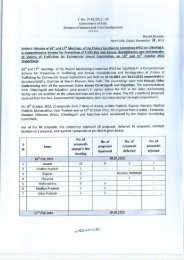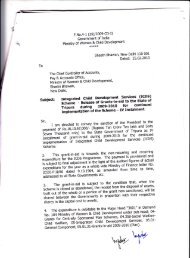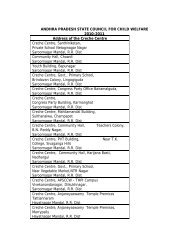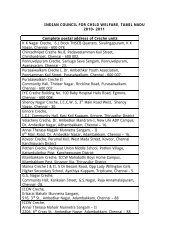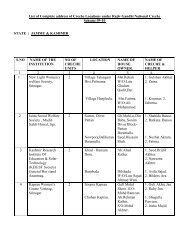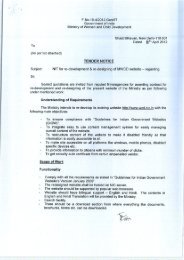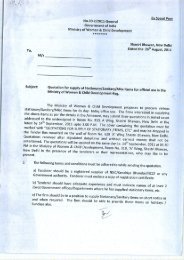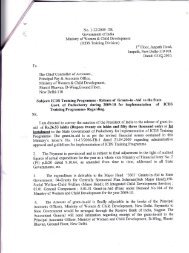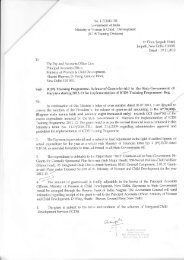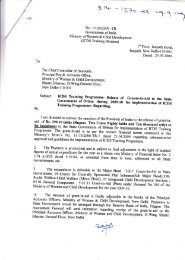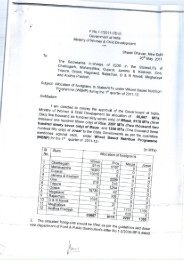COVER HINDI - Ministry of Women and Child Development
COVER HINDI - Ministry of Women and Child Development
COVER HINDI - Ministry of Women and Child Development
- TAGS
- hindi
- ministry
- wcd.nic.in
You also want an ePaper? Increase the reach of your titles
YUMPU automatically turns print PDFs into web optimized ePapers that Google loves.
Checklist I for Gender Specific Expenditure<br />
Box - 4 :<br />
Checklist I for Gender Specific Expenditure<br />
Conventionally, gender budget analysis, by way <strong>of</strong> isolation <strong>of</strong> women related expenditure, has been carried out<br />
for Ministries/Departments like Health <strong>and</strong> Family Welfare, Rural <strong>Development</strong>, Human Resource<br />
<strong>Development</strong>, Urban Employment <strong>and</strong> Poverty Alleviation, Youth <strong>and</strong> Sports Affairs, Labour, Social Justice<br />
<strong>and</strong> Empowerment, Tribal Affairs, Drinking Water, Small Scale Industries <strong>and</strong> Agro <strong>and</strong> Rural Industries,<br />
Science <strong>and</strong> Technology, Non-Conventional Energy Sources, Textiles <strong>and</strong> Agriculture.<br />
Suggested steps that may be undertaken by these various Ministries/Departments who are running programmes/<br />
schemes <strong>of</strong> a gender specific nature i.e. where the targeted beneficiaries are primarily women are as follows:<br />
Planning <strong>and</strong> Budgeting<br />
i. List <strong>of</strong> schemes <strong>and</strong> programmes which are gender specific<br />
ii. Briefly indicating activities undertaken under the programme for women.<br />
iii. Indicating expected output indicators like number <strong>of</strong> women beneficiaries, increase in employment <strong>of</strong><br />
women, post project increase in resources/income/skills etc.<br />
iv. Quantifying allocation <strong>of</strong> resources in annual budget <strong>and</strong> physical targets there<strong>of</strong>.<br />
v. Assessing adequacy <strong>of</strong> resource allocation in terms <strong>of</strong> population <strong>of</strong> targeted beneficiaries that need the<br />
concerned schematic intervention, the trend <strong>of</strong> past expenditure etc.<br />
Performance Audit<br />
vi. Reviewing actual performance- physical <strong>and</strong> financial vis a vis the annual targets <strong>and</strong> identifying<br />
constraints in achieving targets (like need for strengthening delivery infrastructure, capacity building<br />
etc.)<br />
vii. Carrying out reality check- Evaluation <strong>of</strong> programme intervention, incidence <strong>of</strong> benefit, identifying<br />
impact indicators like comparative status <strong>of</strong> women before <strong>and</strong> after the programme etc<br />
viii. Compiling a trend analysis <strong>of</strong> expenditure <strong>and</strong> output indicators <strong>and</strong> impact indicators.<br />
Future Planning <strong>and</strong> Corrective Action<br />
ix. Addressing constraints identified from step (vi) above.<br />
x. Establishing requirement <strong>of</strong> Resources in terms <strong>of</strong> population <strong>of</strong> targeted beneficiaries/ magnitude <strong>of</strong><br />
perceived problems like IMR, MMR, literacy ratio etc.<br />
xi. Reviewing adequacy <strong>of</strong> resources available – financial <strong>and</strong> physical like trained manpower etc.<br />
xii Planning for modification in policies <strong>and</strong>/or programmes/schemes based on results <strong>of</strong> review.<br />
100 Annual Report 2006-07



